Danakil Depression
The Afar region of Ethiopia, known for its unique geological features, is home to one of the most surreal travel destinations in the world – the Danakil Depression. This geological depression, also known as the Afar Depression, is situated in the northeastern part of Ethiopia, near the border with Eritrea and Djibouti. It is one of the lowest points on Earth and is infamous for being one of the hottest inhabited places on Earth with temperatures that may reach as high as 140 degrees Fahrenheit. Despite its inhospitable environment, the Danakil Depression is a popular destination for those who seek adventure and want to witness some of the most breathtaking natural wonders in the world.
The Danakil Depression is a vast area of salt pans, salt lakes, and active volcanoes. The region is dotted with salt mines, where salt is extracted by camel caravans, and salt deposits can be seen as far as the eye can see. The vast salt flats of Lake Karum, with their slabs of salt, sparkle like diamonds under the scorching sun. The region is also known for its hot springs and sulfur springs, which are a result of the volcanic activity in the area.
The Danakil Depression is part of the larger Afar Depression, which is a geological depression that stretches from the Danakil Desert in Ethiopia to the Red Sea. The Afar people, who inhabit the region, are known for their resilience in the face of such an inhospitable environment. The depression is one of two places on Earth where tectonic plates are moving apart at a rate of about 1 inch per year, causing frequent earthquakes and volcanic activity.

The Danakil Depression is a unique destination that offers visitors an unforgettable experience. It is best to visit the Danakil Depression between November and March, as this is the time of year when the temperatures are more bearable. Tour operators and tour companies offer Danakil Depression tours, which usually last for four to six days. During the tour, visitors can witness the stunning beauty of the region and explore the various geological features that make the Danakil Depression so unique.
One of the highlights of the Danakil Depression tour is the Etra Ale volcano, which is an active shield volcano in Ethiopia. The lava lake at the summit of the volcano is a spectacular sight to behold, and visitors can hike to the summit to witness it up close. The night tour to the Etra Ale volcano is an experience like no other. Visitors can spend the night on the summit and witness the stunning beauty of the volcano under the stars.
Another highlight of the Danakil Depression tour is the Dallol geysers, which are hot yellow sulfur springs that bubble up from the ground. The geysers are among the sparkling white salt beds and colorful mineral deposits that create an otherworldly landscape. Visitors can walk among the sparkling white salt beds and explore the colorful mineral deposits to experience what it must feel like to be on a different planet.
Geography and Climate
The Danakil Depression is a geological depression in the Horn of Africa, located in northeastern Ethiopia, close to the borders of Eritrea and Djibouti. This area is known as one of the hottest places on earth, with daytime temperatures reaching up to 50°C (122°F).
The region is dominated by a harsh and inhospitable landscape characterized by an array of geological features such as active volcanoes, salt flats, hot springs, and sulfur deposits. The depression is part of the East African Rift system, which extends from the Red Sea to Mozambique.
The Danakil Depression is a significant camel caravan route for centuries, connecting the highlands of Ethiopia with the coastal regions of Eritrea and Djibouti. The salt pans of the depression have been a source of wealth for the local Afar people for generations.
The area is home to several active volcanoes, including the Erta Ale volcano, which is known for its consistent lava lake. The region also experiences seismic activity due to its location on the East African Rift system.
Despite its harsh conditions, the Danakil Depression is a unique and remarkable destination for travelers who are up for an adventure. To explore the region’s geological wonders, visitors typically start their journey from the Ethiopian capital, Addis Ababa, before heading to the small town of Mekele. From there, they will travel by camel caravan to the depression’s various sites, including the salt flats and hot springs.
Main attractions in the Area
The Danakil Depression is home to some of the most unique and breathtaking attractions on earth. Here are some of the top things to see and do in this extraordinary destination:
One of the most iconic attractions of the Danakil Depression is Dallol, an otherworldly landscape of colorful mineral formations, acid ponds, and bubbling hot springs. As the world’s lowest land volcano, Dallol is an extraordinary geological wonder that showcases the immense power and beauty of nature. Visitors to the region can explore this unique landscape on foot or by camel, marveling at the vibrant reds, greens, and yellows that make up this surreal environment.
Another must-see destination in the Danakil Depression is Erta Ale, an active shield volcano with a lava lake that is visible from afar. The stunning views from the top of Erta Ale are well worth the challenging hike, with visitors able to watch the bubbling lava as it churns and spits. Visitors can also experience the unforgettable feeling of camping overnight near the volcano, under a sky full of stars.
Lake Assale is the Danakil Depression’s largest salt flat and is used for salt mining. This vast, shimmering expanse of salt is a sight to behold, with salt miners working in the harsh conditions of the depression to extract salt slabs from the sparkling white salt beds. Visitors can witness this process firsthand, seeing the hard work that goes into the extraction of the salt, which is then transported by camel caravan.
The local Afar people and their camel caravans are also a significant attraction in the region. Visitors can observe the traditional lifestyle of these nomadic people, who have lived in this inhospitable environment for centuries. The Afar people are known for their resilience and resourcefulness, using the natural resources of the depression to survive in the harsh conditions.
The Danakil Depression is also home to numerous hot springs and sulfur springs, which offer visitors a chance to relax and enjoy the therapeutic properties of the warm, mineral-rich waters. These pools of hot, yellow water are surrounded by stunning geological formations, offering a unique and otherworldly experience.
Visitors should note that the Danakil Depression is one of the hottest and most inhospitable places on earth, so it’s important to plan accordingly. The best time to visit the region is during the cooler months, from November to March. Visitors should also only travel with reputable tour operators and companies, who can ensure that the trip is safe and enjoyable. Despite the challenging conditions, the Danakil Depression offers a once-in-a-lifetime experience that is sure to leave a lasting impression.
Planning Your Visit to Danakil Depression in Ethiopia
Although the Danakil Depression is a harsh and isolated place to visit, it can be well worth the effort if you come prepared. Here are a few things to think about as you organise your trip to this one-of-a-kind destination.
Getting There:
Getting There: Due to its isolated position, getting to the Danakil Depression might be difficult. Flying into Mekele, which is located around 800 miles north of the Ethiopian capital of Addis Ababa, is the most convenient option. From there, you may either independently arrange for a journey to the Danakil Depression or join a tour group headed in that direction. A trip to the Danakil Depression by automobile takes around two days, and you should be prepared for some tough terrain along the way.
Permits & Fees:
The Danakil Depression is only accessible with a government-issued permit, which may be purchased from a licenced tour operator in Ethiopia. You’ll have to pay a different amount for your permit based on how long you want to stay and how many people will be in your party. Some areas may be off-limits due to volcanic activity or other hazards, and it’s important to keep in mind that the region is always changing. Therefore, make sure to check in with your tour operator regularly in case your schedule needs to be adjusted.
Safety Tips:
Safety Tips: With temperatures that may reach over 140 degrees Fahrenheit, the Danakil Depression is unquestionably one of the most inhospitable locations on Earth. As a result, it’s important to bring along the right gear, such as a hat, sunglasses, long-sleeved shirts, and sturdy shoes. Due to the scarcity of restaurants and convenience stores, it is also wise to pack a first aid kit, as well as lots of water and food. Stay with your tour group and listen to your guide, especially if you’re in an area with a history of volcanic activity or other potential dangers.
Accommodation:
Accommodations in this area are limited and usually basic due to the harsh environment. Here are some options you might consider for accommodations near the Danakil Depression:
- Campsites: There are some basic campsites set up by tour operators specifically for visitors exploring the Danakil Depression. These camps typically offer tents or basic structures for shelter and necessary facilities for a comfortable stay.
- Mobile camps: Some tour operators organize mobile camps that move with the expedition groups. These camps are equipped with tents, sleeping gear, and basic amenities to accommodate visitors during their exploration of the Danakil Depression.
- Local guesthouses or lodges: In towns or settlements like Berhale and Hamdela near the Danakil Depression, there might be local guesthouses or lodges available for overnight stays. These accommodations might have limited facilities but can provide a place to rest before or after your expedition.
- Tours with inclusive accommodations: Many tour companies offer guided tours to the Danakil Depression, and accommodations are often included as part of the package. These accommodations may vary from basic campsites to more comfortable options depending on the tour package.
- Sleeping in vehicles or tents: In some cases, visitors opt to sleep in their tour vehicles or set up their own tents equipped for extreme conditions as accommodations in this harsh environment.
Frequently Asked Questions
What is the Danakil Depression and where is it located?
The Danakil Depression is a geological depression located in the Afar region of northern Ethiopia. It is a vast, sunken plain that stretches over 200km and lies at one of the lowest points on earth, at 125m below sea level. The depression is also part of the Great Rift Valley, a geological fault line that runs for thousands of kilometers through eastern Africa.
Why is the Danakil Depression considered the hottest place on earth?
The Danakil Depression is considered one of the hottest inhabited places on earth due to its location in a desert region near the Red Sea, where temperatures can reach up to 50°C (122°F). In addition, the depression sits on an active volcanic ridge, which contributes to the high temperatures in the region.
What are some of the unique geological features found in Danakil Depression?
The Danakil Depression is known for its unique geological features, including Dallol, the world’s lowest land volcano, and a colorful, otherworldly landscape, Erta Ale, an active shield volcano with a lava lake, Lake Afrera, a massive salt flat used for salt mining, and sulphur springs. The depression is also composed of vast salt deposits and salt pans.
What is the history of the Afar people and their connection to Danakil Depression?
The Afar people have lived in the Afar region, including the Danakil Depression, for thousands of years. They are one of the oldest indigenous groups in Ethiopia and have a rich cultural history. The Afar people have long been involved in the salt mining industry in the region, using traditional methods and camel caravans to transport the salt to markets.
How did the camel caravans and trade routes impact the area?
Camel caravans have been a part of the Afar people’s way of life for centuries, transporting goods across the harsh terrain of the Danakil Depression. The caravans played a significant role in the region’s salt trade, which was an important source of income for the Afar people. The trade routes also facilitated the exchange of goods and ideas between different cultures in the area.
What are some safety concerns when visiting Danakil Depression?
Visiting the Danakil Depression can be hazardous due to the extreme heat, harsh terrain, and the presence of an active volcano. Visitors should come prepared with appropriate clothing and equipment, including sturdy shoes, sunscreen, and plenty of water. It is also advisable to travel with a reputable tour company that has experienced guides and proper safety measures in place.
What are the accommodation options available for visitors?
Accommodation options in the Danakil Depression are limited and basic, but visitors can still find suitable options. Some tour operators offer camping facilities and basic guesthouses. These accommodations usually have minimal amenities and services due to the remote location of the region. It is recommended to check with your tour company about the accommodation options available.
What is the best time to visit Danakil Depression?
The best time to visit the Danakil Depression is during the cooler months of November to February, when temperatures are not as extreme. Visitors should avoid the hot and rainy seasons, which can make the terrain difficult to navigate. The best time to visit also depends on personal preference and the specific attractions one wants to see.
What are some must-see attractions in Danakil Depression?
The Danakil Depression offers a unique landscape that is unlike any other place on earth. Must-see attractions in the region include Dallol, the world’s lowest land volcano with its colorful and otherworldly landscape, Erta Ale, an active shield volcano with a lava lake, Lake Afrera, a massive salt flat used for salt mining, and the local communities and camel caravans in the Afar region. Other attractions include hot springs, sulfur springs, and vast salt deposits.
How do I get to Danakil Depression from Addis Ababa or Djibouti?
The Danakil Depression is located in the Afar region of northern Ethiopia, near the border with Eritrea and Djibouti. Visitors can reach the region via road or air. There are regular flights from Addis Ababa to Mekele, the capital of the Tigray region, which is the main gateway to the Danakil Depression. From Mekele, visitors can take a 4×4 vehicle to the depression. It is also possible to travel to the region from Djibouti via a 4×4 vehicle. However, visitors are advised to use a tour operator or guide for their trip to ensure their safety and comfort.




